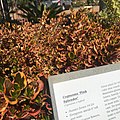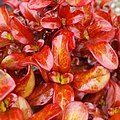| Coprosma repens | |
|---|---|

| |
| Scientific classification | |
| Kingdom: | Plantae |
| Clade: | Tracheophytes |
| Clade: | Angiosperms |
| Clade: | Eudicots |
| Clade: | Asterids |
| Order: | Gentianales |
| Family: | Rubiaceae |
| Genus: | Coprosma |
| Species: | C. repens
|
| Binomial name | |
| Coprosma repens | |
| Synonyms | |
|
Coprosma baueriana Hook. f. | |
Coprosma repens is a species of flowering shrub or small tree of the genus Coprosma, in the family Rubiaceae, native to New Zealand.[1] Common names include taupata, tree bedstraw,[2] mirror bush, looking-glass bush, New Zealand laurel and shiny leaf.[3][4][5]
Description
[edit]The habit of this species varies markedly with its situation. In exposed situations, such as cliffs, it assumes a prostrate habit, while in more sheltered areas it can grow as a small tree up to 8 metres in height.[6] It has thick and very glossy leaves which vary considerably in size, depending on exposure to the elements. The leaf margins are recurved, occasionally to the extent that the leaf may be cylindrical in cross-section.[6] The shiny leaves aid its survival near coastal locations.
C. repens is dioecious. Flowers are produced in spring and summer, with the male flowers appearing in dense, compound clusters, and the female flowers in smaller clusters.[4] Male flowers have a funnel shaped corolla that is 5 mm long, with lobes equal to the tube. Female flowers have a short calyx, and a tubular corolla 3 mm long, with lobes shorter than the tube. Female plants produce orange-red ovoid drupes, which are about 8 mm in diameter and 10 mm in length.[6]
Distribution
[edit]The species is native to the North Island, South Island, Kermadec Islands and Three Kings Islands in New Zealand.[6]
In Australia, it has become naturalised in coastal areas of Victoria, New South Wales, South Australia, Western Australia and Tasmania,[4] and it is now classified as an environmental weed.[3]
Cultivation
[edit]The species has been popular in coastal gardens due to its resistance to salt spray.[3] Although it prefers well-drained sandy soils, it can cope with heavier soils.[5]
There is a large number of cultivars:
- 'Coffee Cream' - creamy yellow leaf margins
- 'Coppershine' - foliage with a copper-bronze tinge
- 'Evening Glow' - golden foliage which changes to rich orange and pink-red shades during autumn and winter[7]
- 'Marble Chips' - leaves with white margins and speckles
- 'Picturata' - leaves with a golden central area
- 'Pink Splendour' - leaves have pink and maroon shaded margins
- 'Rainbow Surprise' - a small cultivar with small pink and yellow-green leaves
- 'Taupata Gold' - cream leaves with green centres
- 'Variegata' - leaves with a creamy-white margin
- 'Yvonne' - compact form with dark-green leaves[8]
The cultivars 'Marble Queen'[9] and 'Picturata'[10] have gained the Royal Horticultural Society's Award of Garden Merit (confirmed 2017).[11]
Gallery
[edit]-
'Coffee Cream' - a garden variety
-
'Copper Shine'
-
'Evening Glow'
-
'Inferno'
-
'Marble Chips' variety
-
'Picturata'
-
'Pink Splendour'
-
'Rainbow Sunshine'
-
'Tequila Sunrise' variety
-
'Wax Wings' variety
-
'Variegeta'
References
[edit]- ^ "WCSP". World Checklist of Selected Plant Families. Retrieved 8 June 2019.
- ^ BSBI List 2007 (xls). Botanical Society of Britain and Ireland. Archived from the original (xls) on 2015-06-26. Retrieved 2014-10-17.
- ^ a b c "Weed Identification - Looking glass bush". Weeds Australia. Australian Weeds Committee. Archived from the original on 2012-04-20. Retrieved 2012-08-14.
- ^ a b c "Coprosma repens A.Rich". PlantNET - New South Wales Flora Online. Royal Botanic Gardens & Domain Trust, Sydney Australia. Retrieved 2009-04-26.
- ^ a b "Shiny Leaf - Coprosma repens". Environmental Weeds of the South East. Department of Environment and Heritage South Australia. Archived from the original on 2009-05-23. Retrieved 2009-04-26.
- ^ a b c d "Coprosma repens". Flora of New Zealand Series. Landcare Research. Retrieved 2009-04-26.
- ^ Coprosma repens 'Evening Glow'
- ^ Kirsten, Keith; Lizelle Meyer-Faedda (2001). Gardening with Keith Kirsten. Struik Press. ISBN 1868725073. [dead link]
- ^ "RHS Plant Selector - Coprosma repens 'Marble Queen'". Retrieved 15 April 2020.
- ^ "RHS Plant Selector - Coprosma repens 'Picturata'". Retrieved 15 April 2020.
- ^ "AGM Plants - Ornamental" (PDF). Royal Horticultural Society. July 2017. p. 22. Retrieved 24 January 2018.












